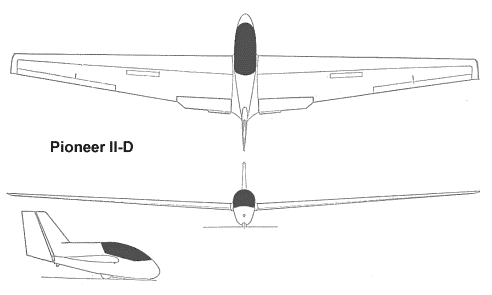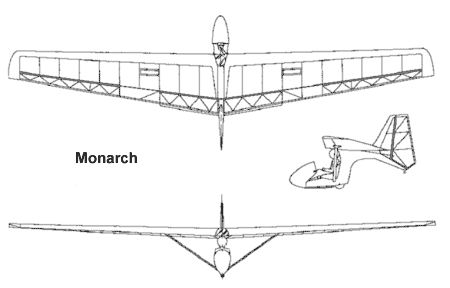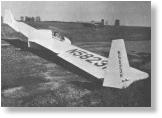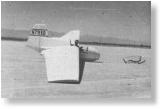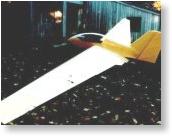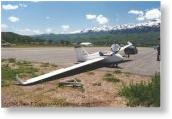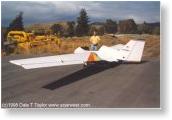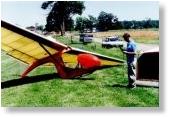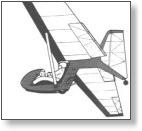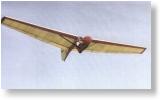| http://www.survol.cjb.net |
Marske "Pioneer" et "Monarch"
Among the designers influenced by the creations of Charles Fauvel, the American Jim Marske is undoubtedly the most inventive and prolific. His first flying wing, the XM-1 glider, made its first flight in 1957. On this prototype, numerous configurations were tested: wingtip fins, central fin, spoilers, flaperons,... Based on these experiments, Jim Marske, aided by Bill Daniels, flew the Pioneer I in 1968. This glider was distinguished from the earlier one by a higher aspect-ratio wing of trapezoidal planform, with a slight forward sweep. While the XM-1 used a Faubel airfoil section with a relative thickness of 14 %, the Pioneer I used a NACA 23112 modified by raising the trailing edge. Roll control was by spoilers, but the machine used a more conventional fuselage-mounted rudder for yaw control. This was later modified after the first fight tests by adding a fixed portion in order to improve its effectiveness. The span of the glider was also increased, justifiying a change of designation to Pioneer I-A.
Later the lighter Pioneer II-A was developed, with a glass-fiber fuselage and ailerons for roll control. It made its first flight in 1972. The following model, Pioneer II-B, had a longer canopy and a section based on the NACA 33012/33010 allowing an improvement in low speed performance. The Pioneer II-C included a few simplifications and lightening of the fuselage structure. Model Pioneer II-D, currently in production, is distiguished primarily by its swept fin. Its maximum glide ratio is 35, despite a low aspect ratio (less than 13). Stall speed is below 60 km/h, and the glider is stall resistant and completely spinproof. It is sold as a kit to amateur builders, assembly requiring approximately 600 hours.
A model with a wing stretched to 15 m and a more streamlined fuselage, the Pioneer III is to be put into production in the next few years. With a maximum glide ratio of about 42, and with a low stall speed, this glider should combine high speed performance and safety at low speed, at a lower cost.
The Monarch made its first flight in 1974. Aimed more at open-cockpit enthusiasts than at soaring pilots, it offers good slow-flight performance, allowing weak thermals to be exploited. The pilot is seated in the open behind a fairing, even with the leading edge and below the high-mounted wing, the latter slightly swept forward and reinforced by two struts. The flight controls are of the conventional 3-axis type, the rudder pedals operating the rudder and the stick controlling the alerons and elevators.
An attempt was made in 1976 to motorise the Monarch using a McCulloch 12 hp engine installed behind the cockpit, driving a 0.6 m propeller. As this small diameter did not allow adequate performance to be achieved, the experiment was not pursued. The Monarch is easily trailerable; it is sold as a kit like the Pioneer. It allows narrow thermals to be exploited with complete safety thanks to its low stall speed (39 km/h).
Jim Marske also designed, under the auspices of the Genesis group and in cooperation with aerodynamicist John Roncz, the Genesis high-performance glider. For more information on his machines, you can consult the Marske gliders site: www.continuo.com/marske.
Translated from the French by Marc de Piolenc (piolenc@reporters.net).
| Characteristics and performance of the Marske gliders | ||
| Pioneer II-D | Monarch | |
| Wing span | 12.98 m | 12.80 m |
| Length | 3.81 m | 3.71 m |
| Wing area | 13.38 m2 | 17.19 m2 |
| Airfoil | NACA 33012 - 75 | NACA 43012 - 75 |
| Aspect ratio | 12.59 | 9.5 |
| Empty weight | 159 kg | 100 kg |
| Max. weight | 295 kg | 204 kg |
| Stall speed | 57 km/h | 39 km/h |
| Glide ratio | 1:35 at 97 km/h | 1:19 at 85 km/h |
| Sink rate | 0.70 m/s | 0.82 m/s |
